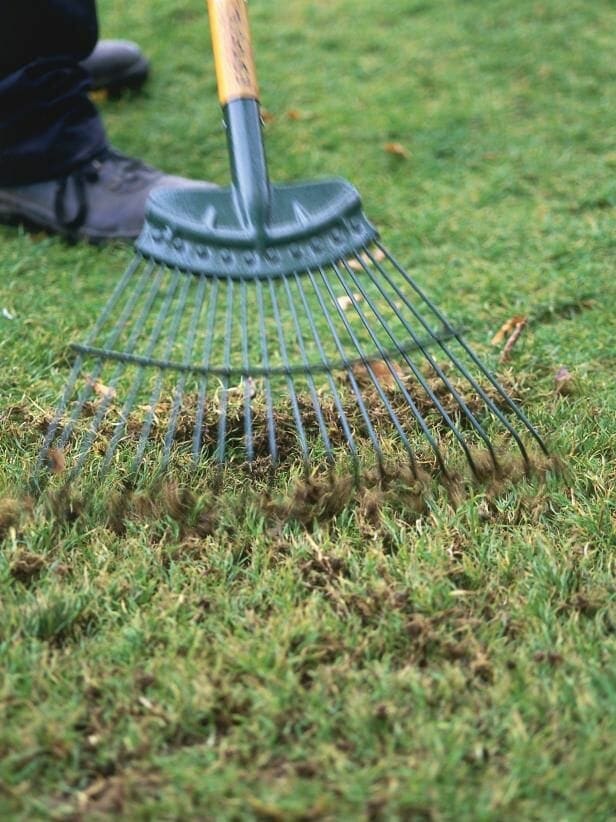Written by Pamela Baker and published on https://backyardables.com/
Most people don’t realize that their grass goes dormant in the winter, which means that you probably don’t need to water your lawn at all during the winter months. As much as 50% of water waste is from outdoor water usage such as over-watering, leaks in the irrigation system, and broken or misdirected sprinkler heads.
To winterize your lawn, you need to choose and apply the proper winter fertilizer and prepare your lawn and its soil for the hard winter months. There are many ways to accomplish this, including removing weeds and leaves, mowing your lawn, and checking the pH level of the soil.
In this article, we will explore some effective ways you can winterize your lawn. We will start with selecting and applying the proper winter fertilizer.
5 Easy Steps to Winterizing Your Lawn
Fall is the best time of year to aerate, fertilize, seed, and give a little extra TLC to your lawn.
During autumn, it is important to prepare your lawn for the upcoming winter or as some call it, winterizing. Taking time to properly care for your grass by aerating the lawn to allow for moisture and nutrients to reach the roots, applying the correct fertilizers, reseeding, debris removal and proper lawn cutting will help ensure a beautiful green lawn in the spring.

Your lawn has survived the long hot, dry days of summer.
As both you, and your blades of green grass breathe in the cool autumn air, it’s time to start on winter preparations to guarantee a beautiful lush lawn in the spring.
Basic lawn winterization can be broken down into 5 easy steps:
- Aeration
- Fertilization
- Seeding
- Debris Removal
- Proper Lawn Cutting
Things to Consider when Winterizing Your Lawn
Before preparations begin to get your lawn ready for its long winter snooze, you need to make sure that you are giving your specific grass the right type of love and care.
Determine Your Grass Type
It is very important to determine what type of grass you have before you start on your winterizing preparations.
Grass types are broken down into two categories: Warm Season grasses, and Cool Season Grasses.
Warm Season Grasses
Warm Season Grasses are grasses that do best in warm-weather regions of the United States.
Some Warm Season Grass Types include:
- Bermudagrass
- Carpetgrass
- St. Augustine
- Bahiagrass
- Zoysiagrass
According to The Lawn Institute, these grasses have their optimum growth when the temperature gets between 80-95 degrees.
These species are primarily found in the American Southwest, and South.
Cool Season Grasses
Cool Season grasses grow best in the fall and spring, while they don’t usually grow in the summer due to high temperatures and low moisture.
They have their optimum growth when temperatures fall between 60 to 75 degrees.
Some types of Cool Season turf grass inculdes:
These grasses are usually used in the northern portion of the United States including states such as Utah, Michigan, Ohio, Pennsylvania, and Nebraska.
Transitional Zones
In between the zones where warm season and cool season grasses grow is a transitional zone.
The transitional zone, where it gets too cold for Warm Season grasses, and too hot for Cool Season grasses can be tricky.
In states such as Virgina, Oklahoma, Arkansas, and northern New Mexico, and Texas planting a combination of the two types is necessary for a green lawn.
In cases such as this, individuals grow warm season type grasses during the part of the year that they do well, and them overseed them with Cool Season grass seed, which grows when it is their optimum time.

Step 1: Aerating Your Lawn for Winter
Aerating your lawn is an easy, yet crucial step in autumn lawn maintenace and should be done first before any fertilizing or seeding is to take place.
Basically, aerating is making lots of small holes in the soil so nutrients, water, and air can find their way to the grasses’ roots.
Why Aerate?
Soil has a tendency to become compacted, especially when it is continually watered and trodden upon.
When the roots of grass can’t get sufficient water, air, or nutrients their roots can’t supply needed nutrients to help maintain the grass during stressful time of heat or lack of rain.
The grass then starts to lose its color and begin to thin out, leaving you with a patchy, or even a dead lawn.
Lucky for you, aerating is a simple and fun process that can be done very quickly.
How to Aerate a Lawn
Since aerating is basically poking tons of small holes in your lawn, all you need is the proper equipment to penetrate through compacted soil.
There are three types of aerators, spike, slicing, and core/plug aerators.
One of the most commonly used, and cheapest aerators are the spike aerators.
They come in different forms, such as the spiked aerators that you strap onto your shoes like sandals and walk around the lawn, or rolling aerators that you push around like an old fashioned push lawn mower.
So to aerate your lawn, using the aerator tool of choice, puncture holes throughout your entire lawn.
Tada! You just completed the first step of winterizing you lawn.
Step 2: Fertilizing Your Lawn for Winter
Now that your grassroots can breathe and take in nutrients, it is time for the next step of winterizing your lawn.
Autumn is a perfect time to fertilize your lawn .
After surviving the stresses of heat and lack of moisture during the summer, your lawn is in dire need of replenishment.
If you would like a specific fertilization plan for your yard, invest in a soil analyst kit or consult your local college extension office to see what fertilizers are best for your area.
Fertilizing Warm Season Grasses
Warm season grasses benefit from one last fertilization in the early fall, two months before the first anticipated frost at the latest.
Depending on your area, this would be between late August until mid-October.
If you miss the deadline for early fertilization, wait to fertilize your lawn until spring.
Warm season grass needs time to process and store nutrients before going dormant in the winter.
Applying fertilizer after this point can cause the grass to put energy into new growth, when it should be preparing to go dormant for the winter.
Tender new growth will suffer from frost damage, and not grow well in the spring.
According to Texas Master Gardener, it is important to give your grass some extra nutrients to store over the winter so they have enough for when spring comes.
If the lawn doesn’t get enough fertilizer, the lack of nutrients can cause patches of sickly looking grasses.
On the other side, if a lawn is over fertilized, it can cause burning of the grass or excessive growth in certain spots, causing a very irregular look for your lawn.
Fertilizing Cool Season Grasses
As with the warm season grasses, cool season grasses have exerted most of their nutrients while surviving summer conditions.
K-State Research and Extension mentions that the fall fertilization is the most important to cool season grasses, because of cooler temperature, more moisture, and plenty of daylight.
During the fall, cool season grasses put most of their strength into their roots.
This is because, unlike warm season grasses, cool weather grasses don’t go dormant.
However, fertilizer should still be applied before the first frost.
How to Fertilize Your Lawn
Most fertilizers are made of one or more of the following three ingredients:
- nitrogen
- phosphorus
- potassium.
As mentioned before, since soil composition can vary widely, it is recommended to get the soil tested to see what it lacks.
The soil analysis should tell you what your soil has enough of, and what it lacks.
Once you determine what nutrients your soil needs, measure your lawn to determine it’s square footage.
If you have a large rectangular lawn, simply multiplying width by height will give you its square footage.
If there are flower beds, or other objects that take up space on the lawn, simply measure their areas and subtract them from the overall width times height of the yard.
Texas A & M Agrilife Extension breaks down how to calculate the amount of fertilizer needed for a lawn.
- Soil test results will tell you how many pounds of a certain nutrient you need to add to 1,000 square feet of the yard.
- Looking at a fertilizer bag, there should be 3 numbers in the #-#-# format. Also known as a fertilizer analysis, these numbers tell you the percentage of nitrogen, phosphorus, and potassium is in the fertilizer.
- Make sure you get fertilizer that has only the nutrients you are looking for.
- Look for the weight of the bag and multiply by the nutrients percentage to determine how many pounds of the fertilizer you need. For example if the fertilizer analysis number for nitrogen is 20, and the bag of fertilizer is 50 lbs., 50 x .20= 10. You would have 10 lbs. of nitrogen in the bag.
- If your soil test results say you need 20 lbs. of nitrogen 1000 square feet of lawn, you would need to buy and spread 100 lbs. of fertilizer.
If trying to figure out these calculations brings back horrible memories of Junior High Math class, check out this fertilizer calculator by Purdue University.
Applying Fertilizer
Before applying fertilizer to your lawn, check the back of the package for specific instructions.
Generally, it is recommended to water the lawn a few days prior to fertilizing.
The best way to apply fertilizer is to use a spreader, which is usually in the form of a small green push cart with distributor attached to the underneath.
Do not try to spread fertilizer with your hands!
Fertilizers are made of chemicals and can cause skin irritations and possible poisoning if ingested.
Do not open a bag and start pouring, this will give you uneven coverage and areas with concentrated fertilizer will burn.

Step 3: Seeding Your Lawn for Winter
Fall provides ideal conditions to seed your lawn, especially if recently aerated and fertilized.
This is a great time to add more seed to sparse patches, introduce a new variety, or overseeding your lawn to have green grass most of the year around.
Filling in Bare Spots
Use this oportunity to add new grass seed into areas that are bare or sparse.
Seed will not take in areas that are too crowded.
Make sure that the seed is in an area that will be well irrigated and receive ample sunlight.
Dormant Seeding
In an article by Bob Mugaas, University of Minnesota Extension Educator, he goes through the steps of dormant seeding.
Basically, grass seeds are planted after the prime fall growing season and go straight into their dormant phase and emerge in the spring.
He mentions that seeds that take root and grow before the first frost are most likely to die.
Overseeding
Overseeding is a great option for individuals in zones where it is hard to maintain either warm or cold season grasses.
Cool season grass seed is dispersed over existent warm season grass to provide color and vivacity while the warm season grass is dormant.
How to Add Seed
Mow the grass and remove plant debris right before seeding the lawn to allow the seeds the best chance of making contact with the soil.
Then, using a spreader, just like when you fertilized, use a spreader to ensure even and through distribution.
You can seed a lawn immediately after fertilizer is applied, as long as no herbicides are present.
After seeds are dispersed, give the lawn a through watering.
Step 4: Debris Removal for Winter
Aside for the satisfying crunch underfoot, there is no benefit for dried autumn leaves during the winter.
In fact, leaving leaves on your lawn before and after the first snowfall is actually a detriment to your grass.
The University of Minnesota lists 3 reasons why you should break out the leaf blower and rakes:
- Leaves smoother grass and make it so they do not get sufficient sunlight making grass less likely to grow properly.
- Promotes snow mold diseases.
- Gives rodents cozy little places to stay during the winter while they wreck havoc on your turf.
However, leaves can be beneficial to your yard if properly composted.
How to Compost Fall Leaves
There are several different methods or equipment that help break down leaves into some awesome plant food for the spring.
If you want to invest in a compost tumbler, special bin, or just a spot in the corner of the yard, you can create some amazing compost very easily and cheaply.
All of them, however stick to 3 basic principals:
- Shredding or cutting leaves into small pieces.
- Applying a source of nitrogen, such as vegetable scrapes or manure (recommended 4 parts leaves to 1 part nitrogen source).
- Addition of oxygen
So after all of the leave piles have been jumped on, and it’s time to turn in for the winter, think ahead to the coming spring and how beautifully green your yard will be with your own homemade, organic compost.
Step 5: Proper Lawn Cutting in the Fall
As the daylight begins to disappear in the daytime, the growing time for grass will start to slowly shorten.
It is recommended to slowly begin to lower the cutting blade on the lawn mower, gradually reducing height from the beginning of fall until the last cut before winter.
This is to help the grass not suffer from shock if it is suddenly hacked down before the first frost comes.
To determine how much to lower the blade, determine the tallest cut setting you use, and how short you want your grass to be in the wintertime.
Then, determine how many cuttings you will do between the beginning of fall until the first frost.
Divide the difference of first and last of the season’s grass heights with the number of mowing to get the amount to lower the blade for each cutting.
It is a good idea to keep grass short during the winter time to discourage rodents from settling in your turf during the winter time.
At this time, you will also want to start reducing the amount of water you are giving your lawn.
Other Considerations when Winterizing Your Lawn.
When the first snow does begin to fall, be careful not to walk too much on your yard.
It may be tempting to take out the snow shovel and scoop off some of the white stuff, but by doing so can actually damage your turf.
Snow acts like a big fluffy blanket, protecting the grass underneath.
Too much trampling will damage or even kill your lawn.
Ready for A Green Spring
Winterizing your lawn really isn’t very hard.
With a little time and effort, and by using these five simple steps, your grass will be able to survive winter, and you can look forward to a lush and green lawn in the coming spring,
Original post here https://backyardables.com/5-easy-steps-to-winterizing-your-lawn/.



